- page 2 -
(The Study of Threes)
http://threesology.org
3 different types of "crosses" have been argued concerning Jesus' crucifixion:
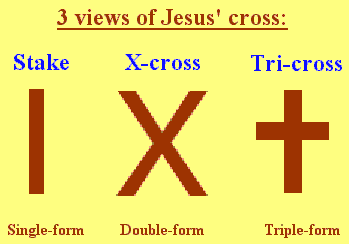
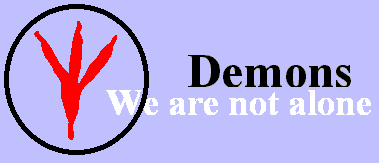
I label the typical (modern day) cross form as a tri-cross, because it gives the impression of a 3-pronged trident. (It is interesting to compare this notion of a "trident" impression with the trident-looking bird's-foot image on the right that is being used by some Jewish writers as a symbol of demons.)
While the last (tri-cross) example has been illustrated in a variety of ways depending on the artist and culture, I have used a simple form for the purpose of referencing a clear view of another 1 - 2 - 3 pattern that many people are aware of on individual terms, but have not placed each of them together as a collective representation of an underlying cognitive pattern. While some would argue that Jesus was tied to the stake instead of being nailed, the fact still remains that we have 3 colloquial views of the quantity of nails being used:
- Stake- one nail was used to bind the hands, though some might want to argue that two nails could have been used...one for the hands and one for the feet.
- X-cross- two nails were used to bind the hands, though some might want to argue that each hand and foot could have had a separate nail.
- Tri-cross- predominant view is that three nails were used, one each for the hands and a single one for both feet.
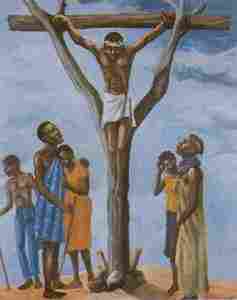
The "Y" cross example might be viewed as a variation of the (culturally/environmentally- specific) 2-branched type transitioning into a 3-branched" variety with either a cross-beam (as shown) or simply the head of Jesus figuratively viewed as the third (and middle) branch, just as he is often portrayed in artwork as being in the middle of two others who are being crucified, thus in another interpretation, each of the three can be seen as a single branch having its own (interconnected) root-variety of lookers-on while they died. (A three-lane highway of lookers-on at a traffic accident can be symbolically thought of as three interconnected roots (or branches). As an aside note, the middle child in the family is commonly viewed as the revolutionary though the label of rebel may be used as a term of trying to discredit them by those who want to keep everything as it is in a way they may call "traditional," as if this word is supposed to convey something good, better, best.
Y-cross image source:
In providing examples of the "three" in religion, I am not trying to make a religiously-preferenced point that advocates one religious view over another, but a point about human cognition that uses various themes in which to present the same pattern over and over and over again, and that this usage is linked to an environmentally influenced genetically- predisposed development in consciousness. This development in consciousness is no doubt linked to the various forms of oral history we encounter in different cultures.
This is an important consideration because many people rightly note that there is no biblical reference to the usage of three nails, there is only an ongoing word-of-mouth transference that becomes adopted as a generally accepted reference of collective opinion that illustrates a widespread mindset. In other words, many people choose to repeat the notion of three nails being used instead of some other quantity. They don't say seven nails were used, nor five, nor four, nor two, etc... Hence, the "Three" has a point of origin and necessity for reappearing in the orally transmitted views of people...and thus portrays an example of an aspect of mental functioning of many people. Likewise, there is a continual orally transmitted tradition of saying that Christ had dropped the cross three times, even though there are no biblical references to the quantity of times the cross was actually dropped, how many nails were used, nor what type of cross was actually used. The point to be made is that there is a repeated reference to the quantity of "three."
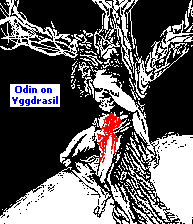 Norse god Odin |

Jesus |
Prometheus |
On which side were either Odin or Christ stabbed? I don't know. I simply placed both stabbings on the same side as a means of continuity in viewing the two together in order to make the comparison a little easier for some observers. The biblical reference of John 19:34 gives an account of blood and water, but it doesn't say which side he was stabbed on. And neither does it say that Christ was stabbed in the heart, as is told by some interpretations. The presence of water might give the impression he was stabbed in the stomach (suggesting that he did in fact take a drink at some time) which indicates he was stabbed on the left side. We might even consider the bleeding of Prometheus on the rock as a symbolic extension of this same male sacrificial figure.
Odin image source:
Christ image source:
http://www.oloswestriver.org/cross_history.htm
As seen in the above images, another correlation to the idea of Christ dying and being stuck with a spear on the (elongated plus-sign) style of cross seen as the third type in the foregoing three examples, is the Norse story of Odin (Wodin) having been sacrificed on the three-branched Yggdrasil tree and having had a spear stuck in him. While some people conclude that the ideas surrounding the Yggdrasil tree are merely a variation of the Christian ideas of Jesus from a pagan perspective, little reference has been paid to consideration of how the idea of the Yggdrasil's three roots came about. Attempting to put my world-view into the frame of mind shared in the ancient Norse culture where demons, giants, dwarfs, angry gods, etc., were as often discussed as are present day topics on (combatant) sports, (make-believe) movies and (contrived "reality") television programs, I came up with the idea of the three roots of the Yggdrasil tree having been influenced by the shadow of the cross:
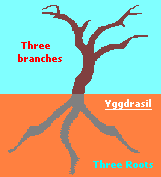
|
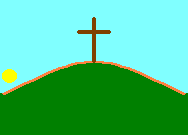 |
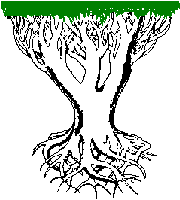 |
The third tree is placed here just for the sake of comparing intellectual concepts. It represents one view of the three branches of basic life domains called the Archaea, Bacteria, and Eukarya. While there is current controversy about if and how the three branches overlap, what is typically considered is that these three came from a single source and it is not customarily considered whether or not there were three roots.
Again and again we encounter a three-branch illustration to represent a three-category idea. We could do the same for DNA's triplet codon system and the three families of fundamental particles, though such a view is not commonly used to describe these three-patterned ideas.
The image is adapted from:
|
I have three heroes in battle, Mael the tall ~ Llyr, with his army~ Caradoc, pillar of Wales. He also names 3 Bard s of Britain: Merlin Ambrose ~ Merlin the son of Morfyn, (called also Merlin the Wild)~ Taliesin, chief of the bards 3 golden-tongued knights: Gawain, son of Gwyar ~ Drydvas, son of Tryphin ~ Eliwlod, son of Madag, and Uther 3 honorable feasts of Britain:
|
3 Losses by Disappearance, refers to 3 voyages that were set out to find "the green meadows of the sea" (called in the triads Gwerddonau Lion: the Green fairy islands, reposing in sunlight and beauty on Ocean's calm breast). They were supposed to be the abode of the souls of certain Druids, who, not holy enough to enter the heaven of the Christians, were still not wicked enough to be condemned to the tortures of annwn (hell, or the shadow land), and so were accorded a place in this romantic sort of purgatorial paradise.
The 3 voyages are commemorated in the triads:
- In the fifth century a voyage was made by the British king Gavran, in search of these enchanted islands; with his family he sailed away into the unknown waters, and was never heard of more.
- Merlin sailed away in a ship of glass, and disappeared forever.
- Madog sailed in search of America and disappeared forever.
|
If you happen to be a tour guide, it's very easy to memorize the facts about the Church of the Trinity in Waldassen, Germany. Since it has: 3 towers & 3 turrets, each turret with 3 dormer windows 3 windows & 3 roofs with 3 openings in each 3 doors in each part of the structure 3 large & 3 small crosses 3 altars & 3 staircases; 3 doorways & 3 columns; 3 lights & 3 niches 3 bays & 3 windows in each bay 3 statues of the Virgin Mary. The designer was George Dientzhofer, the 3rd architect in his family. The church took exactly 33 months, 333 weeks, & 33 days to build. It cost 33,333 florins & 33 kreuzer. |
Salem Witchcraft Trials: Fear of witches reached panic proportions after:
A teenaged girl had an argument with a washer- woman. The next day, the girl had convulsions and complained of pains all over her body.
When her younger brother and
Sister also complained of pains, the washer- woman was brought to trial on the suspicion of being a witch. She was convicted and hanged. (It has been considered that the pains are but one example of other symptoms of a disease caused by a mosquito.)
3 parts to each Astrological sign called a decanate or decan.
Homer & other Greek poets wrote of a legendary ship called a Trireme. The 120 foot long wooden vessels were powered by 170 oarsmen on three levels, whose main task was to ram enemy ships at high speed.
3 days: May 9, 11, 13, are when expiatory rites were held to expel the lemurs (ghosts), Evil spirits of the dead who often appeared as skeletons and were known to strike the living with madness. The temples were closed and marriages were prohibited. (Roman Myth)
3 Buddhist existences:
- Parikalpita-svabhava
- Paratantra-svabhava
- Parinispanna-svabhava
3 senseless creatures of Buddhist mythology: Tiger (anger) ~ Monkey (greed) ~ Deer (love-sickness)
3 intoxifications of Buddhism: Hate ~ Ignorance ~ Lust
3-lettered names to denote Buddha: Foh, Fuh, Pot, Put, But
3 body physiques of Buddha:
-
Thin (African... recurring famines?)
-
Medium (Indo- European... intermediate/indeterminate feasting?)
-
Obese (Asian... over-fed spiritual/political figures?)

Glencairn Museum |

Lanka |
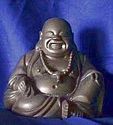
Imagine Hawaii |
Triad in Occult Philosophy: The Vital Soul ~ The Animal Soul ~ The Rationalized Soul
3-fold law of Karma believed by religious witches: "Magic returns to the sender magnified 3 times."
3-patterned phrase on Nazi belt buckle: "Gott Mit Uns" (God With Us)
|
(God with us!) 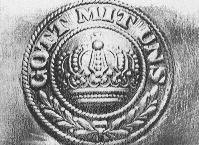 World War I - belt buckle of the soldiers of the German Emperial Army. |
(God with us!) 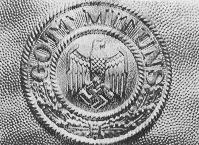 World War II - belt buckle of the soldiers of Hitler's Wehrmacht. |
Information and buckle images source:
3-patterned Nazi Party membership number of Adolf Hitler: 555 (The actual number is said to be 55, but the German Party started membership numbers at 500, in order to give the impression of having a large following.)
3 patterned philosophy in Moonie religion: One Heart ~ One World ~ One God
3 sixes (666) or 616 have been used to represent the Anti-Christ, Devil, Satan, Evil one, etc.
3 eights (888), in antiquity, was the sacred number of Jesus.
| ihsous = Jesus | ||||
| i | = | iota | = | 10 |
| h | = | eta | = | 8 |
| s | = | sigma | = | 200 |
| o | = | omicron | = | 70 |
| u | = | upsilon | = | 400 |
| s | = | sigma | = | 200 |
| 888 | ||||
The early Christian Sacred Geometers called a circle with a circumference of 888 units "the living Jesus" because the diameter of his circle is 282 units, which is the gematria value of the Greek word bios (BioV), meaning "life."
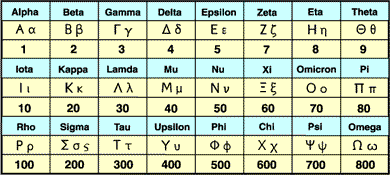
The Greek alphabet was invented almost one thousand years before the birth of Christ. At the time it was invented, every one of the 24 letters in the Greek alphabet represented a number as well as a sound.
(Note: As a correlation to the foregoing "24 letters", perhaps as a subtle environmental influence, the precession of the Earth's axis is at 23.5 degrees. Some readers might be interested in such a comparison. Another is to include that a child received 23 chromosomes from each parent for a total of 46. One more chromosome results in genetic "anomalies" such as Down's syndrome.)
The first eight letters represent units, (the "0" power of "10").
The second eight letters represent tens, (the "1st" power of "10").
The third eight letters represent hundreds, (the "2nd" power of "10").
The 8-8-8 structure of the table holding the letters of the Greek alphabet is directly related to the name "Jesus". Since every name and word in the Greek language had a corresponding numerical value, words could be expressed as numbers and numbers could be expressed as words. This made the Greek alphabet a public cipher and immediately encouraged two numerical superstitions called ISOPSEPHIA and GEMATRIA. The total of all the numbers in the Greek alphabet is "3999."
Initially created: Saturday, January 01, 2011
First Posted: Friday, March 28, 2014
Updated posting: Friday, April 4, 2014
Herb O. Buckland
herbobuckland@hotmail.com